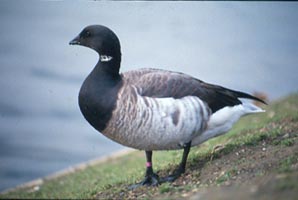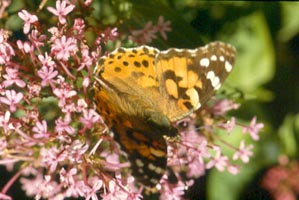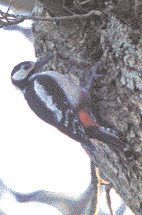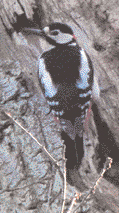| Dalkey Tidy Towns |
  |
| Dalkey Tidy Towns |
  |
|
Wildlife
Newsletter for the Township of Dalkey May 2011 - Michael Ryan |
|
HAMMERING
in the PARK |

 Woodpeckers in Cabinteely
Woodpeckers in CabinteelyPhotos: Justin McCarthy |
|
|
When seen in flight Great Spotted Woodpeckers are a dramatic flash of black, white and red but when they’re feeding flat against the trunk of a tree they can be difficult to see, being only the size of a starling, so there’s no guarantee of seeing it. What has often caused confusion in Ireland in the past was people hearing a tapping noise coming from the trees and figuring they’d heard a woodpecker. Almost certainly what they’d heard was a hooded crow which have a habit of clattering together the two sides (known as mandibles) of their bill. But as I approached the trees behind Cabinteely House a sound rang out which certainly wasn’t a rattling crow. A loud hollow drumming noise was echoing around the wood. The woodpecker was there anyway, whether I’d be able to see it was another question. I wandered around the wood and then came upon a chap with a large camera set on a tripod. He’d travelled up from Wexford to see the woodpecker, arriving at 7.30 and though he’d already been there two hours he’d only got a glimpse of the bird flying overhead. I didn’t hold out any chance of seeing it but anyhow it was a lovely morning, the low morning sunlight filtering through the trees and it was no hardship to hang around for a while. Didn’t have to wait long though. My companion called my attention to the woodpecker which had just flown on to a tree above us and began hammering at a piece of the tree trunk stripped of bark and pockmarked where the birds bill had been hitting it before. Woodpeckers have a number of adaptations to protect them from the incredible force their tapping might have on their head. They have a very long tongue, used to scoop up insects from the tree trunks and this tongue actually wraps around their brain protecting it. They have extra tissue in their skull which acts as a protective pad to absorb the force of their hammering. It was fantastic to watch him and hear him at the same time. |
| The photographer, Justin McCarthy took a few shots of the bird before he flew off again to the other side of the wood to drum from another tree. I asked Justin could I use a couple of his photos for this article and he sent me the attached. Then another friend arrived to look for the bird, he’d been up six times before looking for the bird but hadn’t seen it until now. I realised I’d been very lucky, only spending a short time before seeing it. It’d be very lucky if a female woodpecker arrives but the male bird was still hammering away in early April so if he didn’t get paired up it certainly wasn’t from lack of trying. |
Should you feed wild birds in Summer? |
Photo: M. Ryan |
If you were asked what’s the commonest summer migrant to come to Ireland you might be inclined to think its the swallow. The beginning of April has a lot of our summer migrant birds arriving and beginning to sing. Maybe because it’s often milder on that side of the hill I’d often hear my first Chiffchaffs and Blackcaps singing in the trees above the Vico Road. They do often appear in gardens as well, maybe feeding up after a long flight over the sea. Last April we spent an awful long time trying to identify a little warbler that hung around the garden pond for a few days. I knew it was either a chiffchaff or a Willow Warbler but couldn’t decide which. These two birds are notoriously difficult to tell apart and if it’s identity is in doubt a individual may be referred to as a ‘Willow Chiff’ or a ‘Wiffwaff”. Chiffchaffs usually, but not always, have much darker legs and a prominent lower eye ring. hey’re a bit duller then the Willow Warbler but that’s not a great diagnostic when the light is very bright. One good tip is the chiffchaff flicks its tail more often but often it barely flicks it at all. Even professional researchers who catch birds to put rings on them can find it difficult to separate them except for one foolproof method. |
| In the past it used be said that you should stop feeding birds during spring and summer since parent birds might feed unsuitable food like peanuts to their young which might choke them. There was very little proof of this happening and although large bits of peanuts could in theory choke baby birds it’s very unlikely the parents would feed them unsuitable food. Most young birds are fed insects or bits of worms by their parents, food that is easily digestible and full of protein. Two of the biggest bird conservation groups in Europe, the RSPB (Royal Society for the Protection of Birds) and the BTO (British Trust for Ornithology) have conducted a lot of research and studies into the benefits of summer feeding and concluding any negative benefits are outweighed by the positive benefits. Both organisations advocate feeding birds in the summer as long as the food is suitable and sufficient care is paid to hygiene. Ultimately you’re feeding the parent birds leaving them more time to get suitable food for their chicks. In recent summers the weather has at times turned unseasonably cold and wet reducing the supply of insects and caterpillars and then food provided for them can be literally a life saver. |
 Female Sparrowhawk near nest. Photo: M. Ryan |
%20and%20male%20bullfinch%20on%20sunflower%20feeder.jpg) Female (front) and male bullfinch on sunflower feeder Photo: M. Ryan |
In hot summers the ground can get very hard making it difficult for blackbirds, thrushes and robins to dig up earthworms. Be sure the food isn’t left out uneaten for long periods as it might develop mould or become rancid. Water is very important any time of the year but especially during hot spells. Never put out loose peanuts, dry hard foods, large chunks of bread, or fats and make sure the feeders are cleaned regularly in the warmer weather. I’ve been feeding birds during the summer for years often getting more birds at the feeders in summer then in winter, especially seed eaters like greenfinches and chaffinches. Last summer saw the arrival on our sunflower feeders of bullfinches, birds which had previously been unknown to come to garden feeders. They’ve been coming constantly since, often two or three pairs feeding at the same time and they’re always a lovely very welcome sight. |